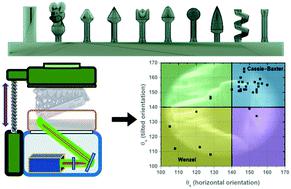当前位置:
X-MOL 学术
›
Soft Matter
›
论文详情
Our official English website, www.x-mol.net, welcomes your feedback! (Note: you will need to create a separate account there.)
Superhydrophobic μ-pillars via simple and scalable SLA 3D-printing: the stair-case effect and their wetting models
Soft Matter ( IF 3.4 ) Pub Date : 2021-07-07 , DOI: 10.1039/d1sm00655j José Bonilla-Cruz 1 , Jo Ann C Sy , Tania E Lara-Ceniceros , Julio C Gaxiola-López , Vincent García , Blessie A Basilia , Rigoberto C Advincula
Soft Matter ( IF 3.4 ) Pub Date : 2021-07-07 , DOI: 10.1039/d1sm00655j José Bonilla-Cruz 1 , Jo Ann C Sy , Tania E Lara-Ceniceros , Julio C Gaxiola-López , Vincent García , Blessie A Basilia , Rigoberto C Advincula
Affiliation

|
In nature, superhydrophobic surfaces (SHSs) exhibit microstructures with several roughness scales. Scalable fabrication and build-up along the X–Y plane represent the promise of 3D printing technology. Herein we report 3D printed microstructures with a dual roughness scale that achieves SHS using a readily available Formlabs stereolithography (SLA) printer. Pillar-like structure (PLS) arrangements with a wide range of geometrical shapes were 3D printed at three resolutions and two printing orientations. We discovered that a tilted printing direction enables a stair-case pattern on the μ-PLS surfaces, conferring them a μ-roughness that reduces the solid–liquid contact area. The programmed resolution governs the number of polymerized layers that give rise to the stepped pattern on the μ-PLS surfaces. However, this is reduced as the printing resolution increases. Also, all samples’ experimental contact angles were consistent with theoretical predictions from Cassie–Baxter, Wenzel, and Nagayama wettability models. The underlying mechanisms and governing parameters were also discussed. It is believed that this work will enable scalable and high throughput roughness design in augmenting future 3D printing object applications.
中文翻译:

通过简单且可扩展的 SLA 3D 打印实现超疏水 μ 柱:楼梯效应及其润湿模型
在自然界中,超疏水表面 (SHS) 表现出具有多种粗糙度的微观结构。沿X - Y方向的可扩展制造和构建平面代表了 3D 打印技术的前景。在此,我们报告了具有双粗糙度标度的 3D 打印微结构,使用现成的 Formlabs 立体光刻 (SLA) 打印机实现 SHS。具有多种几何形状的柱状结构 (PLS) 排列以三种分辨率和两种打印方向进行 3D 打印。我们发现倾斜的印刷方向可以在 μ-PLS 表面上形成阶梯状图案,赋予它们 μ-粗糙度,从而减少固液接触面积。编程的分辨率控制了在 μ-PLS 表面上产生阶梯图案的聚合层的数量。但是,随着打印分辨率的增加,这种情况会减少。此外,所有样品的实验接触角都与 Cassie – Baxter、Wenzel、和 Nagayama 润湿性模型。还讨论了潜在的机制和控制参数。相信这项工作将实现可扩展和高吞吐量的粗糙度设计,以增强未来的 3D 打印对象应用。
更新日期:2021-07-28
中文翻译:

通过简单且可扩展的 SLA 3D 打印实现超疏水 μ 柱:楼梯效应及其润湿模型
在自然界中,超疏水表面 (SHS) 表现出具有多种粗糙度的微观结构。沿X - Y方向的可扩展制造和构建平面代表了 3D 打印技术的前景。在此,我们报告了具有双粗糙度标度的 3D 打印微结构,使用现成的 Formlabs 立体光刻 (SLA) 打印机实现 SHS。具有多种几何形状的柱状结构 (PLS) 排列以三种分辨率和两种打印方向进行 3D 打印。我们发现倾斜的印刷方向可以在 μ-PLS 表面上形成阶梯状图案,赋予它们 μ-粗糙度,从而减少固液接触面积。编程的分辨率控制了在 μ-PLS 表面上产生阶梯图案的聚合层的数量。但是,随着打印分辨率的增加,这种情况会减少。此外,所有样品的实验接触角都与 Cassie – Baxter、Wenzel、和 Nagayama 润湿性模型。还讨论了潜在的机制和控制参数。相信这项工作将实现可扩展和高吞吐量的粗糙度设计,以增强未来的 3D 打印对象应用。



























 京公网安备 11010802027423号
京公网安备 11010802027423号